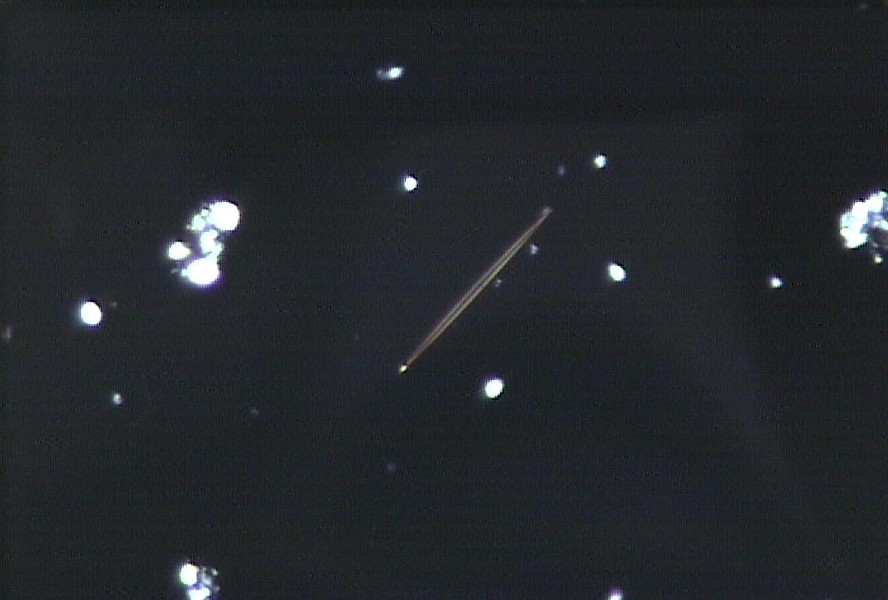Apparent Birefringence in Glass Fiber
There is an air bubble trapped between these two glass fibers that are bound together at their terminations. The high refractive index difference between the air and the glass results in much of the light being reflected at the interface. When viewed between crossed polars the small amount of light that is transmitted becomes visible against the dark background. If one of the polarizing filters is rotated the small amount of light transmitted appears dark relative to the much greater intensity of light coming through the adjacent field of view.
Transmitted Crossed Linear Polarized Light
The second cause of apparent birefringence is due to absorption of light at the edge of a conductive material. Opaque objects can be identified as conductive or non-conductive by the presence or absence of light at their edge when viewed between crossed polarizing filters.
Glass fiber is a fiber composed of a material in a "glassy" state. A "glass" is any of a large class of materials that solidify from a molten state without crystallization and with random molecular orientation. They are regarded physically as supercooled liquids rather than true solids (based on the definition in the AMERICAN HERITAGE DICTIONARY). Chemically they generally contain silicon along with a number of other elements though carbon-based glasses are also common in some environments. It is estimated that there are in excess of 50,000 different chemical compositions for glass (MATERIALS HANDBOOK, by George S. Brady and Henry R. Clauser). Glass is easily formed at elevated temperature and can be made into fibers intentionally, as an artifact of thermal forming, or as a natural process as in the case of volcanic glass fiber (Pele's Hair).
"Glass fiber", as identified by light microscopy, is defined by its morphology and a few optical properties. Its cylindrical shape (a result of surface tension at elevated temperature) is best seen by the relief gradient at the edge of the fiber when viewed with transmitted oblique illumination. The random molecular structure is demonstrated by the fact that the fiber is isotropic (disapears in all orientations when viewed between linear polarizing filters at 90 degrees to one another). The brittle nature of the fiber is shown by the lack of plastic deformation at the terminations of the fiber.
http://www.microlabnw.com/index/Glass%20Fiber%20and%20Health%20Complaints.pdf
Parker, Sybil P. (ed), McGRAW-HILL ENCYCOPEDIA OF PHYSICS, ISBN 0-07-045253-9, p.27.
Definition/Function:
Apparent birefringence is the result of a change in the polarization of light from the polarizing filter in the base of the microscope (the polarizer) by the specimen on the stage that is not the result of birefringence in the specimen. There are two primary conditions that result in apparent birefringence. The first is reflection due to differences in the refractive index of the mounting medium and the specimen. Glass fiber mounted in a medium with a very different refractive index will reflect light preferentially that is polarized parallel to the length of the fiber. The light that transmits at the edge of the fiber will be preferentially polarized perpendicular to the length of the fiber. The result is a rotation of the polarization of a portion of the transmitted beam. A portion of this rotated beam will pass through the polarizing filter above the objective (the analyzer). This is different than the stress birefringence that is some times present at the edge of a glass fiber with an epoxy coating. Stress birefringence is actually due to birefringence induced by stress.The second cause of apparent birefringence is due to absorption of light at the edge of a conductive material. Opaque objects can be identified as conductive or non-conductive by the presence or absence of light at their edge when viewed between crossed polarizing filters.
Glass fiber is a fiber composed of a material in a "glassy" state. A "glass" is any of a large class of materials that solidify from a molten state without crystallization and with random molecular orientation. They are regarded physically as supercooled liquids rather than true solids (based on the definition in the AMERICAN HERITAGE DICTIONARY). Chemically they generally contain silicon along with a number of other elements though carbon-based glasses are also common in some environments. It is estimated that there are in excess of 50,000 different chemical compositions for glass (MATERIALS HANDBOOK, by George S. Brady and Henry R. Clauser). Glass is easily formed at elevated temperature and can be made into fibers intentionally, as an artifact of thermal forming, or as a natural process as in the case of volcanic glass fiber (Pele's Hair).
"Glass fiber", as identified by light microscopy, is defined by its morphology and a few optical properties. Its cylindrical shape (a result of surface tension at elevated temperature) is best seen by the relief gradient at the edge of the fiber when viewed with transmitted oblique illumination. The random molecular structure is demonstrated by the fact that the fiber is isotropic (disapears in all orientations when viewed between linear polarizing filters at 90 degrees to one another). The brittle nature of the fiber is shown by the lack of plastic deformation at the terminations of the fiber.
Significance in the Environment:
The apparent birefringence at the edge of glass fiber must not be confused with the presence of asbestos associated with the glass fiber. Asbestos fibers will some times align with the glass fiber but that alignment will not be perfectly at the edge and it will have an abrupt termination at the end of the asbestos fiber. Some glass fibers mounted in the 1.680 refractive index liquid used to identify amosite asbestos fibers will show some apparent birefringes at the edge of the fibers.Characteristic Features:
Associated Particles:
References:
Brady, George S. and Henry R. Clauser, MATERIALS HANDBOOK, 11th Edition, ISBN 0-07-007069-5, pp. 341-350http://www.microlabnw.com/index/Glass%20Fiber%20and%20Health%20Complaints.pdf
Parker, Sybil P. (ed), McGRAW-HILL ENCYCOPEDIA OF PHYSICS, ISBN 0-07-045253-9, p.27.


